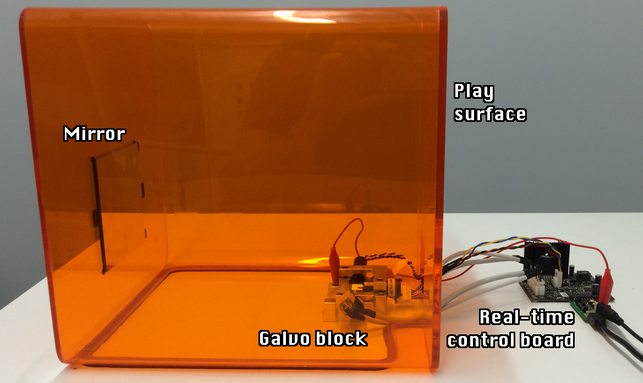What might you do with a few extra stereolithographic 3D printer parts? Why not make a galvo display and resurrect a couple of classic vector graphic games of yore? That’s exactly what [Matt] did. With a few extra Formlabs components and a Haskell implementation of Spacewar, [Matt] can kick back and blast his extraterrestrial foes on the surface of his Formlabs cover.
[Matt’s] source code drives the Form 2 controller board to output laser graphics on the surface of a Form 1 case. These parts might be a commodity for this Formlabs Engineer, but the output is nothing short of spectacular, given the game and USB drivers were put together from scratch. In case you want to give the Haskell source code a try, [Matt’s] kindly included an alternative software-only display using OpenGL.
Unless you’ve just upgraded from Form 1 to Form 2, odds are pretty low that you can pull this one off without breaking either your printer or your wallet. Fortunately, [Alvaro] has paved the way with a stellar galvanometer display that began as a few parts from eBay. At last! Once our Formlab printer warranties expire, we’ll know where to start looking for parts for that mosquito killer we needed.

















Finally! A use for these crappy over-priced 3D printer things!
Liquid resin printers have amazing quality. Example: https://www.flickr.com/photos/sbgraber/with/14493382648/
Expensive? yes. Crappy? No.
Not until he programs Asteroids into it it ain’t.
Woah…..
IIRC most vector setups using galvos run into problems because the speed of the galvo can’t match the speed of the old vector CRTs. In short, Asteroids looks like ass.
Like at this link: http://hackaday.com/2013/03/12/playing-mame-games-on-a-rgb-laser-projector/
I think is is due most people using the laser direct on a large surface forcing the galvos to travel further. But bounce it off a mirror……
Oh crap, that won’t change anything. Nevermind…..
What more complex games need is coordination of two or more pairs of galvos, each pair tasked with drawing specific object sets in each game.
Vector scan CRT games also benefit from the decay time of the phosphor. Shining a laser onto a surface, persistence of vision has to do it all.
So to do a complex vector game like Omega Race or Star Castle, you’d want a reflective or transmissive projection surface with a phosphor coating that has a short decay time so the lasers don’t have to try to move so fast.
Using a mirror is a neat trick. It “folds” the projection path to achieve a reduction in galvo deflection – same as if the galvos were placed farther from the screen.
How about mirrors on piezo actuators like these? http://www.dynamic-structures.com/actuators/?gclid=CMa765OcmcoCFRSRfgod4WAPHg Faster response time than a galvo, would just have to mount the projection system way back from the screen or bounce off a fixed, first surface mirror.
They are probably using one of the 405nm lasers so you could protect that onto a phosphorescent screen and get the persistence of a CRT.
A 405nm laser can excite some glow in the dark stuff very nicely.
Does the (acrylic?) that he’s using fluoresce? It looks like it does. That makes an awesome laser projection screen!
Too bad the FormLabs printer is so terrible at doing useful prints :\
That is pretty awesome!
Haha yeah! I have nothing to say other than “I want it.”
Is there custom firmware for the Form 1+ to control exposure and intensity of laser? Would be nice to tune printer in manual mode.
the more uses of 3d Printer likes this